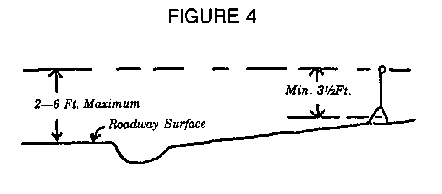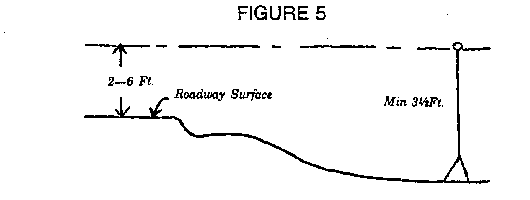 |
Code of Maryland Regulations (Last Updated: April 6, 2021) |
 |
Title 11. Department of Transportation |
 |
Subtitle 14. MOTOR VEHICLE ADMINISTRATION—VEHICLE INSPECTIONS |
 |
Chapter 11.14.07. Noise Abatement Program |
Sec. 11.14.07.08. Site Requirements: Highway Operation for All Vehicles over 10,000 Pounds GVWR or GCWR
-
A. Measurement Site.
(1) The measurement site shall be an open site, essentially free of large sound reflecting objects and not closer than 200 feet between the microphone target point and a tunnel or underpass.
(2) The following objects may be within the site including the triangular measurement area:
(a) Small cylindrical objects such as fire hydrants or telephone or utility poles;
(b) Rural mailboxes;
(c) Traffic railing of any type of construction except solid concrete barriers; and
(d) One or more curbs or surfaces having a vertical height of 1 foot (.3m) or less.
(3) The following objects may be within the measurement site if they are outside of the triangular measurement area of the site:
(a) Any vertical surface (such as billboards), regardless of size, having a lower edge more than 15 feet (4.6m) higher than the surface of the traveled lane of the highway.
(b) Any uniformly smooth sloping surfaces slanting away from the vehicle (such as a rise in grade alongside the highway) with a slope that is less than 45 degrees above the horizontal. See Figure 4.
Figure 4.

(c) Any surface slanting away from the vehicle that is 45 degrees or more and not more than 90 degrees above the horizontal, if all points on the surface are more than 15 feet (4.6m) above the surface of the traveled lane of the highway. See Figure 5.
Figure 5.

(d) Any standing water.
(e) The operator, a witness, or trainee. The operator, witness, or trainee shall be positioned behind the microphone but no closer than two feet to the microphone.
B. Roadway Surface Requirements. The traveled lane of the highway within the measurement site shall be dry, paved with relatively smooth concrete or asphalt, and substantially free of:
(1) Holes or other defects which would cause a vehicle to emit irregular tire, body, or chassis impact noise; and
(2) Loose material such as gravel or sand.
C. Ambient Conditions for Moving Vehicles and Stationary Sites.
(1) Sound. The ambient A-weighted sound level at the microphone location point may be measured, in the absence of motor vehicle noise emanating from within the clear zone, with fast meter response using a sound level measurement system that conforms to Regulation .10 of this chapter.
(2) The measured ambient sound level shall be 10 dB(A) or more below that level specified in Regulation .04 of this chapter, Table 1, 2, or 3, which corresponds to the maximum permissible sound level reading which is applicable at the test site at the time of measurement.
(3) Ambient sound levels need not be taken when a:
(a) Moving vehicle measurement rises to a maximum of 10 dB or more above the measurement start; or
(b) Stationary vehicle measurement rises to a maximum of 10 dB or more above the measurement level before each of the 3 engine run-up sound level maximums.
(4) Wind. The wind velocity at the site may be measured at the beginning of each series of noise measurements and at intervals of 5-15 minutes thereafter until it has been established that the wind velocity is essentially constant. Once this fact has been established, wind velocity measurements may be made at hourly intervals. Testing can be done if velocity is 12 mph (19.3kph) or less, but gust winds up to 20 mph (33.2kph) are allowed.
(5) Precipitation. Measurements are prohibited under any conditions of precipitation; however, measurements may be made with snow on the ground. The ground surface within the measurement area shall be free of standing water.
D. Reflecting Surfaces within Measurement Sites for Moving Vehicles with a GVWR or GCWR of 10,000 Pounds or Less and Motorcycles.
(1) Measurements made at sites with sound reflecting surfaces located behind the microphone line or beyond the vehicle fore and aft center line and outside the triangular measurement area shall be adjusted by the factors in Table 4. If the reflecting surfaces are both behind the microphone and beyond the vehicle, they are additive. Measurements may not be made when a sound reflecting surface is less than 25 feet from the microphone or vehicle or when there are more than two reflecting surfaces within a site.
(2) Tables. The following tables are used for noise measurement site adjustments:
(a) Table 1.
Maximum Sound Levels Highway Operation Type of Vehicle Posted Speed Limit or
Posted Advisory SpeedAny motor vehicle or combination having a GVWR or GCWR over 10,000 Pounds 35 mph or less Over 35 mph Soft
SiteHard
SiteSoft
SiteHard
Site86 dB(A) 88 dB(A) 90 dB(A) 92 d B(A) (b) Table 2.
Maximum Sound Levels Highway Operation Type of Vehicle Posted Speed Limit or
Posted Advisory SpeedAny motor vehicle or combination with a GVWR or GCWR of 10,000 pounds or less 45 mph or less Over 45 mph Any Motorcycle 78 dB(A) 82 dB(A) (c) Table 3.
Maximum Sound Levels Stationary Site Type of Vehicle Limits Any motor vehicle or combination having a GVWR or GCWR over 10,000 pounds After July 1, 1975 103 dB(A) After January 1, 1988 103 dB(A) Any other vehicle or combination with a GVWR or GCWR of 10,000 pounds or less After July 1, 1975 103 dB(A) After January 1, 1988 100 dB(A) Any Motorcycle 100 dB(A) (d) Table 4.
Highway Operation Measurement Site Distance between reflecting surface and
microphone location or target pointAdjustment added
to the limitOver 25 feet but not more than 35 feet 1 dB(A)